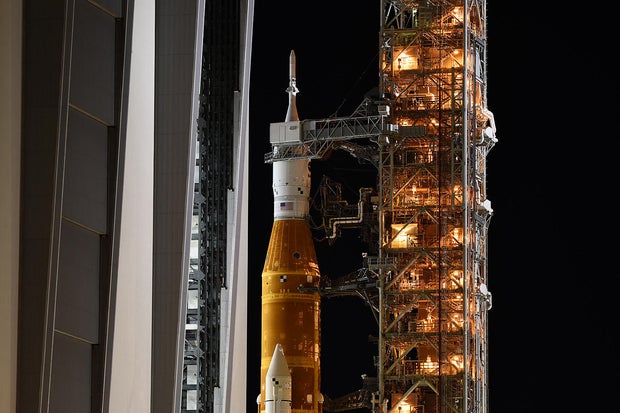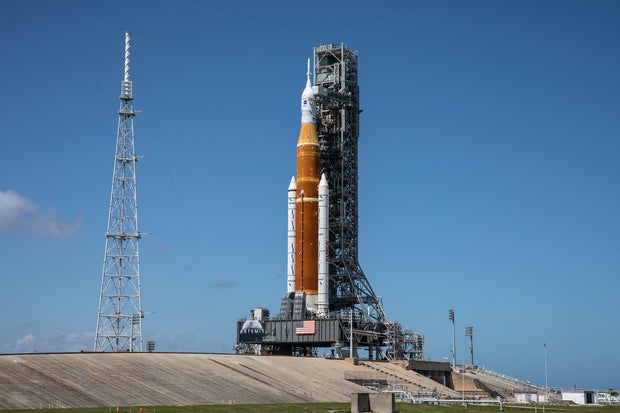NASA sets tentative launch date for Artemis I
NASA's 4.1 billion Dollar's space launch system Moon Rocket was hauled Tuesday from the iconic Vehicle Assembly Building at Kennedy Space Center in Florida to Pad 39B for a 4.2-mile night flight to send the unmanned Orion Deep Space Crew Ship on the voyage. Ready for the long-awaited maiden flight. around the moon.
A powerful Apollo-era crawler transport carrying a 3.5 million-pound, 322-foot-tall SLS rocket and a 10.5 million-pound mobile launch platform began to trickle away from the Kennedy. His VAB cavernous at the Space Center at 9:55pm. His EDT cheered by hundreds of spaceport workers and families.

A thunderstorm in the area delayed the rollout by about an hour, but the move was scheduled for Wednesday at 7am. It was expected to be completed on time. Once the mobile launcher is lowered onto its pedestal above the launch pad, engineers connect power, data, propellant lines, water lines and other systems to prepare the rocket for thorough pre-launch testing and checkout. To do.
If all goes well, the team will begin a 46-hour, 10-minute countdown at 10:23 am EDT on August 27, ending the 8 Departing at 8:33 a.m. on Monday, March 29, it will begin a 42-day flight to send the unmanned Orion Crew Capsule back around the Moon.
On September 2nd and 5th, preliminary launch opportunities will become available based on the ever-changing positions of the Earth and Moon, in addition to the spaceport's propellant resupply needs. Become. The launch will be delayed until later this fall as SLS returns to her VAB to service its batteries and other systems.
The goals of the Artemis 1 mission are to validate the performance of the SLS, test the solar-powered Orion Crew Capsule in deep space, and protect the ship from hellish high pressure with a 16.5-foot-wide heat shield. to make sure. At the end of the flight the velocity rushes into the Earth's atmosphere.
Assuming a scheduled launch, the Orion capsule is scheduled to land in the Pacific Ocean west of San Diego on October 10 at 11:53 am EDT.
If the test flights go well, NASA plans to launch four astronauts on Artemis 2, the second flight of the SLS rocket, in 2024, with a A third mission follows, sending the first woman and the next man to the moon.

The SLS is the world's most powerful operational rocket, with two extended shuttle legacy solid-fuel boosters and four Using two upgraded Shuttle-era RS-25 engines, it produces a total of 8.8 million pounds of thrust, 15% more than NASA's legendary Saturn 5 Moon rocket.
In its initial "Block 1" configuration, the SLS can push about 30 tons to the Moon. A planned variant with a more powerful upper stage and advanced boosters could send about 50 tons to the moon in a single flight.
SpaceX is building a bigger, more powerful Super-Heavy Starship rocket with twice the capabilities of its hers, but not in one flight. The reusable Starship is designed to refuel in Earth orbit before leaving for deep space.
Last year, NASA conducted a full-time test launch of the Boeing-built SLS Core Stage and his four Aerojet Rocketdyne RS-25 engines at Stennis Space Center in Mississippi. The booster was then shipped to Florida, where it was fitted with a United Launch Alliance-provided rocket second stage and a Lockheed Martin-built Orion capsule.
Engineers performed four dress rehearsal countdowns to clear the way for launch, but the tests revealed ground system problems, namely a stuck helium valve and two nasty hydrogen leaks (one (where the main fuel line is connected). The base of the core stage and another of the small fittings used to cool the main engine.
Hydrogen leaks are notoriously difficult to identify and fix, as they only appear when cryogenic propellant is flowing through the lines and fittings. Repairs should be done at room temperature. The
engineer successfully repaired the umbilical his fittings, which functioned normally during subsequent fuel delivery tests. However, after the latest countdown rehearsal he VAB repaired the main engine 'bleed' line has not yet been retested under cryogenic conditions. It won't happen until SLS is ready for his Aug. 29 launch. } William Harwood

I am in charge of full-time. , initially at United Press, where he worked as International's Cape Canaveral bureau chief, and now he is a consultant for CBS News. He has covered 129 of his Space His Shuttle missions, all interplanetary flights since Voyager 2's Neptune flyby, and numerous commercial and military launches. Based at Kennedy Space Center in Florida, Harwood is a dedicated amateur astronomer and co-author of "Comm Check: The Final Flight of Shuttle Columbia."
Thank you for visiting CBS NEWS.
Create a free account or log in to
for more features.


